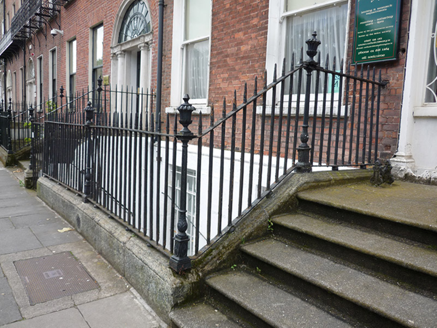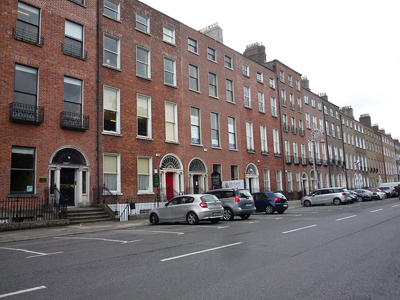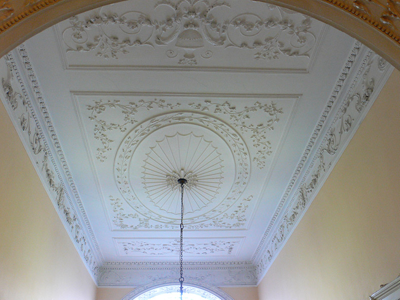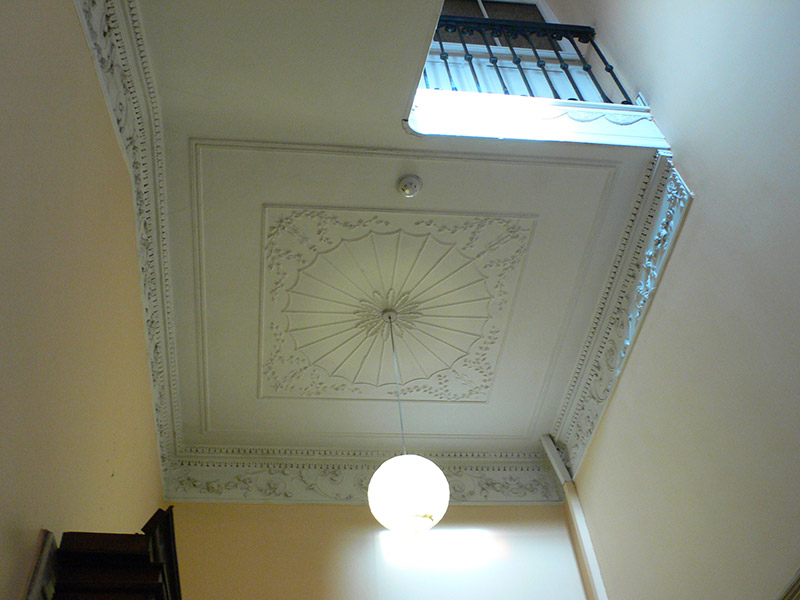Survey Data
Reg No
50100414
Rating
Regional
Categories of Special Interest
Architectural, Artistic
Original Use
House
In Use As
Library/archive
Date
1785 - 1795
Coordinates
316587, 233487
Date Recorded
29/07/2016
Date Updated
--/--/--
Description
Attached three-bay four-storey former house over basement, built c. 1790 apparently as one in terrace of seventeen, bowed to eastern two bays of rear elevation, and having two-storey return to third bay with further storey to north end, and with later lean-to single-storey addition to bowed bays. Now in use as library and offices. Pitched slate roof to front, hipped to west end, behind Flemish bond tuck-pointed brown brick parapet with granite coping, and two hipped slate roofs to rear perpendicular to street, larger to eastern bays. Hipped slate roof to return, with bowed glazed timber corner to first floor with flat roof and having flat roof to further storey. Shouldered rendered and brown brick chimneystack to east with clay pots, concealed gutters to front with cast-iron downpipe to east. Flemish bond brown brick tuck-pointed walls on painted moulded granite plinth over painted ruled-and-lined rendered basement walls. Square-headed window openings, diminishing in height to upper floors, with painted rendered reveals, soldier arches and painted granite sills; painted granite block-and-start surrounds and wrought-iron grilles to basement at front. Timber sliding sash windows, front elevation having six-over-six pane to basement front and one-over-one pane elsewhere; rear elevation has mainly one-over-one pane. Round-headed principal doorway with paired Ionic columns flanking decorative leaded sidelights, supporting fluted frieze and cornice, decorative radial leaded fanlight, cavetto-moulded architrave and twelve-panel timber door with brass furniture. Granite platform with cast-iron boot-scrapes and five bull-nosed granite steps. Wrought-iron railings enclosing basement area, with decorative cast-iron posts on moulded granite plinth. Replacement timber glazed door provides access to basement. Casey notes 'plasterer unashamedly employed Rococo motifs, including...upturned cornucopiae...rendered as comic faces'. carparking to rear of site, and recent residential building to stable lane.
Appraisal
No. 74 Merrion Square is an elegant Georgian house that forms part of the eighteenth-century square developed by the Fitzwilliam Estate. This building has a notable Ionic doorway with sidelights and an elaborate fanlight. It also retains its iron railings and setting details, which are of craft interest and also contribute significantly to the intact appearance of this internationally important architectural set-piece. The interior has good neo-Classical plasterwork, good joinery and fireplaces throughout the main rooms and hall. Its return has an interesting bowed window and the vestibules between the return and the main building are well decorated, and include stained glass. The square is one of the best-preserved Georgian streetscapes in Ireland. The north, east and south sides are lined with terraced houses of eighteenth and early nineteenth-century date, while the west side is terminated by the garden front of Leinster House. The houses maintain a relatively uniform building height and design, attributed to standards promoted in Fitzwilliam's leases. Individuality was introduced through the design of doorcases, window ironwork and interior decorative schemes.

















































